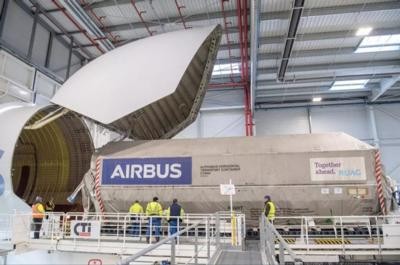Fri, Feb 03, 2023
Upcoming Launch Allows Manufacturer to Put New Plane to Work
Airbus Took the opportunity to brag about its Beluga fleet this week after one of the large cargo jets delivered Inmarsat-6 to the Kennedy Space Center.

The updated and modernized fleet of capacious cargo haulers have become a quintessentially capable part of the company’s fleet, offering their extra large cargo services the world over.
The fleet was put to use delivering the Inmarsat-6 geostationary telecommunications satellite (I-6 F2) ahead of its upcoming launch. The satellite will be based on Airbus' own Eurostar E3000 spacecraft, and will be the 58th of the series built. Once in orbit, it will be the 9th such satellite equipped with electric propulsion for a limited range of orbital position control.
“I-6 F2, with its sophisticated digitally processed payload, will join Inmarsat-6 F1 in orbit giving Inmarsat even more flexibility, capability and capacity," said François Gaullier, Head of Telecommunications & Navigation Systems at Airbus. "This is the 10th geo-telecommunications satellite we have built for our long-term customer Inmarsat, a leading provider of global mobile satellite communication services, and with I-6 F1 the satellites will enable a step change in the capabilities and capacity for their ELERA services, and deliver significant additional capacity for their Global Xpress network.”
The Inmarsat-6 F1 and F2 models feature a large 9-meter aperture L-band antenna and 6 multi-beam Ka-band antennas, granting improved flexibility and connectivity. Next-generation modular digital processors provide full routing flexibility over up to 8000 channels and dynamic power allocation to over 200 spot beams in L-band, per spacecraft. That level of coverage will bolster Inmarsat's efforts at spanning the globe with pole-to-pole internet connectivity throughout the L and Ka bands. They represent the company's first step in building what it calls "the world’s first multi-dimensional network", Inmarsat ORCHESTRA. While it's still years from reaching fruition in the consumer realm, the system is expected to provide a "transformational growth in capacity and features for customers into the 2030s and beyond".
More News
Also: Netherlands Donates 18 F16s, 2 737s Collide On Ramp, E-7 Wedgetail Cut, AgEagle's 100th In S Korea The Pilot and Aircraft Privacy Act was introduced in the House by Represent>[...]
Pilot Also Reported That Due To A Fuel Leak, The Auxiliary Fuel Tanks Were Not Used On June 4, 2025, at 13:41 eastern daylight time, a Piper PA-23, N2109P, was substantially damage>[...]
Have A Story That NEEDS To Be Featured On Aero-News? Here’s How To Submit A Story To Our Team Some of the greatest new stories ANN has ever covered have been submitted by our>[...]
From 2023 (YouTube Edition): Reflections on War’s Collective Lessons and Cyclical Nature The exigencies of war ought be colorblind. Inane social-constructs the likes of racis>[...]
What Goes Around, May Yet Come Back Around, Klyde FMI: www.klydemorris.com>[...]
 Airborne 06.30.25: US v ADS-B Misuse, Natl STOL Fire, Volocopter Resumes
Airborne 06.30.25: US v ADS-B Misuse, Natl STOL Fire, Volocopter Resumes NTSB Prelim: Piper PA-23
NTSB Prelim: Piper PA-23 ANN FAQ: Submit a News Story!
ANN FAQ: Submit a News Story! Classic Aero-TV: One Mans Vietnam
Classic Aero-TV: One Mans Vietnam Klyde Morris (06.30.25)
Klyde Morris (06.30.25)



